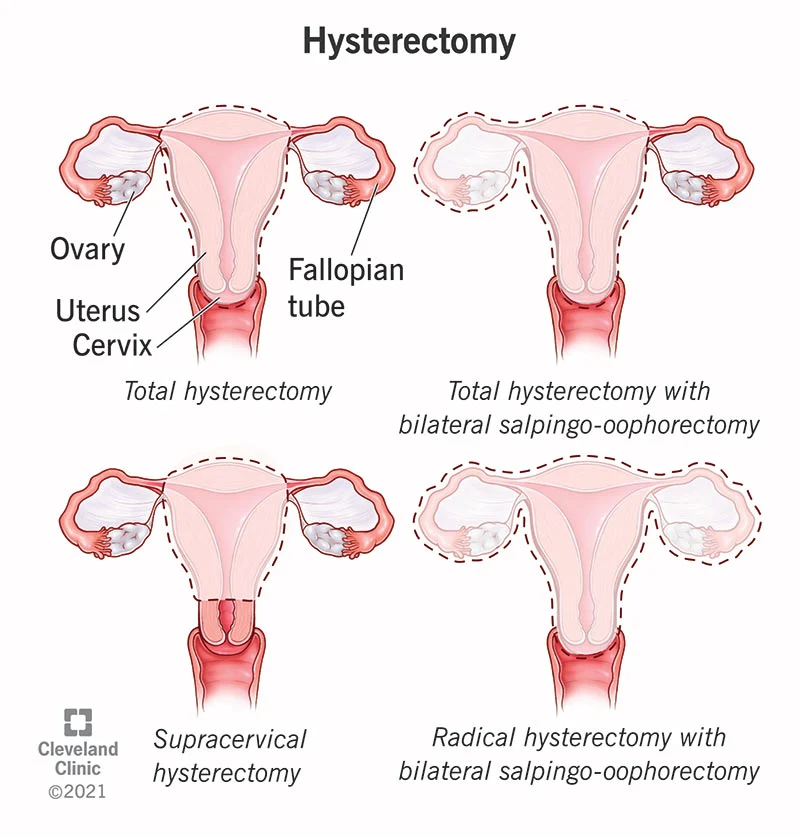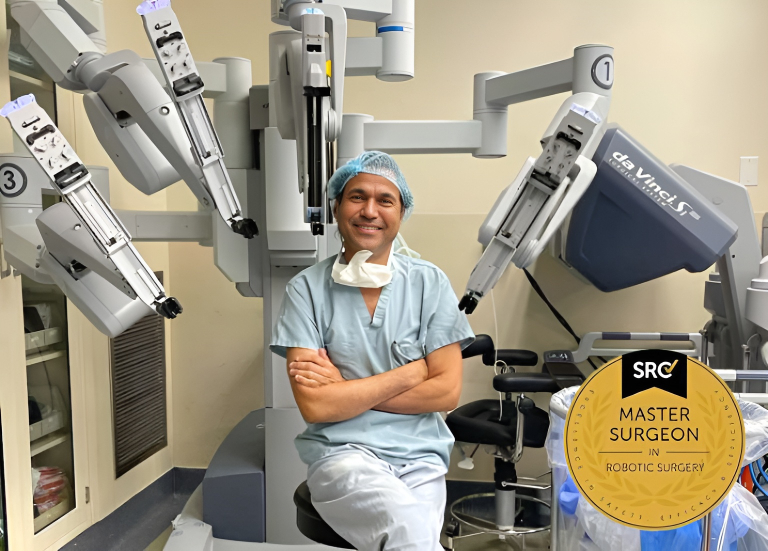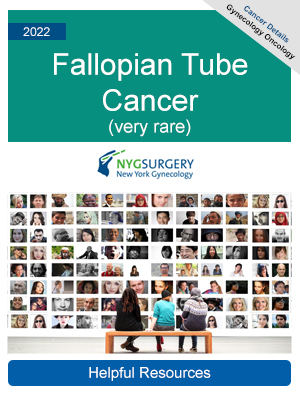Radical Hysterectomy with Bilateral Salpingo-Oophorectomy
- What is Radical Hysterectomy with Bilateral Salpingo-Oophorectomy?
- Common Reason for Radical Hysterectomy with Bilateral Salpingo-Oophorectomy
- Effects After Radical Hysterectomy with Bilateral Salpingo-Oophorectomy
- How Long Does it Take?
- Laparoscopy in Radical Hysterectomy
- NYGS Approach
- Request an Appointment
A radical hysterectomy with bilateral salpingo-oophorectomy is a surgical procedure commonly performed in gynecology to treat various conditions, including certain gynecological cancers and severe cases of endometriosis.
During this procedure, the surgeon removes the uterus (hysterectomy) along with the cervix, surrounding tissues, and sometimes the upper part of the vagina. Additionally, bilateral salpingo-oophorectomy involves the removal of both the fallopian tubes and the ovaries. This comprehensive surgical approach is typically recommended when there is a need to eliminate the primary source of estrogen production (the ovaries) and to ensure the removal of any potential cancerous or precancerous tissues, which might be present in the uterus or the surrounding structures.
It is a major surgery and can have significant implications for a person’s hormonal balance, reproductive capabilities, and overall health

Image Source: Cleveland Clinic
Common Reason for Radical Hysterectomy with Bilateral Salpingo-Oophorectomy
A common reason for performing a radical hysterectomy with bilateral salpingo-oophorectomy is the treatment of early-stage cervical cancer. When cervical cancer is diagnosed in its initial stages and has not spread beyond the cervix, a radical hysterectomy is often recommended. This surgical procedure involves the removal of the uterus, cervix, upper vagina, and surrounding tissues, along with the fallopian tubes and ovaries (bilateral salpingo-oophorectomy). By removing these reproductive organs and adjacent structures, the goal is to eliminate any cancerous cells and prevent the cancer from spreading to other parts of the body. This approach can be curative for early-stage cervical cancer and offers a high chance of long-term survival.
Another common reason for a radical hysterectomy with bilateral salpingo-oophorectomy is the management of certain cases of uterine cancer, especially when the cancer has advanced beyond the uterus. In such situations, the surgical removal of the uterus along with the fallopian tubes and ovaries is performed to address the primary site of cancer and reduce the risk of cancer recurrence. This comprehensive surgical approach is crucial in cases where uterine cancer has spread to adjacent tissues or lymph nodes, as it aims to eradicate the disease and improve the patient’s prognosis.
What are the effects after Radical Hysterectomy with Bilateral Salpingo-Oophorectomy?
A radical hysterectomy with bilateral salpingo-oophorectomy has a long-lasting effects on a woman’s body. This surgery removes the uterus, cervix, fallopian tubes, and ovaries, causing physical and hormonal changes.
Firstly, the surgery triggers surgical menopause because it removes the ovaries, which make estrogen. This can lead to symptoms like hot flashes, night sweats, mood swings, vaginal dryness, and a higher risk of osteoporosis and heart problems due to lower estrogen levels. Many women take hormone replacement therapy (HRT) to relieve these symptoms and reduce the long-term health risks linked to low estrogen.
Secondly, this procedure makes it impossible for women to have natural pregnancies, which can have strong emotional and psychological impacts, especially for those who haven’t finished family planning or want more children later. It’s crucial for women considering this surgery to discuss fertility preservation options with their doctors before the procedure if they hope to have children in the future.
Also, removing the uterus and cervix can affect pelvic support, potentially causing changes in pelvic anatomy and function, though these effects can vary among individuals.
How Long Does a Radical Hysterectomy with Bilateral Salpingo-Oophorectomy Take?
The time a radical hysterectomy with bilateral salpingo-oophorectomy takes can vary based on factors like the surgical method, a person’s body, and the surgeon’s skill. Usually, the surgery lasts about 2 to 4 hours, but it can be shorter or longer. The complexity of the procedure matters too. For instance, if it’s for gynecological cancer and needs more tissue removal or lymph node work, it might take more time compared to a simpler procedure for a different health issue.
Dr. Pankaj Singhal is widely regarded and respected as a Master Surgeon in Robotic Surgeries, having performed over 10,000 robotic gynecologic, endometriosis, and cancer procedures, further emphasizing his expertise and proficiency in this field.
Laparoscopy in Radical Hysterectomy with Bilateral Salpingo-Oophorectomy: A Minimally Invasive Surgical Approach
Laparoscopy is a minimally invasive surgical technique increasingly used in performing a radical hysterectomy with bilateral salpingo-oophorectomy. During this procedure, a surgeon makes several small incisions in the abdominal wall through which specialized instruments and a tiny camera called a laparoscope are inserted. This camera provides a high-definition view of the pelvic and abdominal organs, enabling the surgeon to meticulously remove the uterus, cervix, fallopian tubes, and ovaries.
The benefits of laparoscopy in this context include smaller incisions, which often result in less postoperative pain, reduced scarring, and a faster recovery. Patients typically experience a shorter hospital stay, faster return to their regular activities, and potentially lower blood loss during surgery. The improved visualization afforded by laparoscopy also enhances surgical precision.
NYGS Approach
Facing a Radical Hysterectomy with Bilateral Salpingo-Oophorectomy can be a challenging and emotionally charged experience.
New York Gynecology Surgery (NYGS) is committed to providing personalized care with experienced professionals. Your well-being is our top priority, and we aim to exceed your expectations with high-quality care. If you’re considering this procedure or have concerns, please reach out to us for guidance.
We’re here to support you in this important decision-making process.
Pankaj Singhal, MD, MS, MHCM
- Industry expertise with over 12 years of experience in both academic & private health care settings, physician practice management and executive leadership.
- Trained over 45 gynecologic surgeons along with training fellows in minimally invasive gynecologic surgery and gynecology oncology, and has developed cutting edge, new surgical techniques for endometriosis and laparoscopic surgeries.
- One of the very few surgeons who have completed over 5,718 robot-assisted gynecologic surgeries in the entire United States.
- Known for taking on the most challenging surgery cases that other doctors/centers turn away.

Hear From Our Clients

Joetta Simonette
On May 3, 2018 at Good Samarital Hospital, due to cancer, you performed ovarian surgery on me.
It is now 5 years since that date – 5 years of wellness that has been accomplished through the grace of God guiding your hands and the support of your team and my loving family.
You are an excellent, compassionate and caring doctor who was confident of a good outcome, and so it is!
Thank you, thank you for these past wonderful years. May God continue to bless you. You are in my prayers!

RG Petkos
Power couple Dr. Singhal & Dr. Mclean are amazing!! My experience with them has been absolutely wonderful. I highly recommend either of them for so many reasons mainly for helping me get back some quality of life with my successful full hysterectomy being better than I expected.
The process from the beginning with them was a pleasure and I had quite a challenge beforehand so I’m very grateful that quality, professional, caring doctors still exist!!
I especially appreciate their proactive approach and feel the combination of the care and expertise they provide make for successful outcomes!!

Kimberly Quinde
Dr. Singhal was the doctor who took care of my mother Ivonne Guevara. My mother had gone to 2 other doctors who refused to take care of her fibroid. She was in pain for years and her fibroid had grown really big without her knowing. When my mom went to Dr Singhal she was met with calmness and reassurance that everything will be ok and he would help her get better. Dr. Singhal was so kind and caring all throughout the process.
He took all her worries away and my mom highly recommends him. She hopes every doctor can be as great as Dr. Singhal.
Everyone in his office was so nice to my mom and it was a great experience given the circumstances.
Hospital Affiliations



Request an Appointment
"*" indicates required fields






